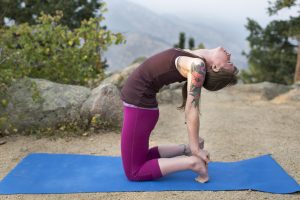 The winter season is often a time of increased Kapha dosha, causing symptoms such as coldness, congestion, depression, stagnation and heaviness. Therefore it is only fitting to choose a Yoga pose that will help to balance some of these common wintertime Kapha issues. Ustrasana, translated as camel pose, is a great choice, as it is well known for its ability to increase circulation, warmth and digestion while removing heaviness and fatigue.
The winter season is often a time of increased Kapha dosha, causing symptoms such as coldness, congestion, depression, stagnation and heaviness. Therefore it is only fitting to choose a Yoga pose that will help to balance some of these common wintertime Kapha issues. Ustrasana, translated as camel pose, is a great choice, as it is well known for its ability to increase circulation, warmth and digestion while removing heaviness and fatigue.
Although tri-doshic by nature, this pose is most notably beneficial for removing Kapha imbalances, creating lightness and energy throughout the entire system. Kapha tends to accumulate in the lungs and heart region, making this back-bending, chest-opening posture even more necessary. Creating space in this region not only removes physical congestion in the lungs, it also removes grief (lungs are the organ of grief) and heaviness on a more energetic level. Further it is said that backbends of all kinds are extremely important for increasing self-confidence and removing dullness in the mind, just another great reason to incorporate them regularly in our practice.
Vata and Pitta will find benefit in this posture too, as it works on both the pelvic region (home of Vata) and the abdominal region (home of Pitta). It alleviate gas, bloating and constipation, while toning the abdomen and balancing the digestive fire (Agni). It works on the nervous system by increasing circulation and heat in the spine, and alleviates reproductive issues by promoting blood flow and removing obstruction in this region.
**Please note that overuse of backbends (including Ustrasana) may cause over-stimulation and increase Vata, especially for those of a Vata constitution or with a Vata imbalance.
Since this is a fairly advanced posture that requires the body to be warm and supple, one should always include this pose (and other powerful backbends) more towards the end of the practice. Further, to counterbalance the concave nature of Ustrasana, one should follow this pose with an appropriate forward fold (i.e. paschimottanasana or balasana) for an equal amount of time.
If the full pose cannot be achieved directly in the beginning, one can always modify by using blocks beside the feet, or simply practicing the side to side variation until the full posture can be held without pain or extreme discomfort. Just as with any Yoga posture, it is always recommended to learn the technique from a knowledgable teacher rather than a book, picture or article.
- Doshic Qualities: Vata ↓,Pitta ↓, Kapha ↓(Best for Kapha; may increase Vata with overuse)
- Best Season for Practice: Most beneficial in Winter; suitable all year round
- Elemental Component: Reduces Earth and Water; balances Fire, Air and Space
- Main Areas of Strengthening in the Body: Spine, lower back, lungs, heart
- Main Organs and Systems: Digestive system, respiratory system, circulatory system, nervous system, endocrine system (especially the thyroid)
Health Benefits of Ustrasana
- Reduces overall Kapha in the system
- Removes heaviness and stagnation
- Increases energy and confidence
- Alleviates a dull, foggy mind
- Increase overall circulation
- Boosts the vital Prana (life force) in the body and mind
- Balances the digestive fire (Agni)
- Alleviates gas, bloating and constipation
- Promotes blood flow to the spine, pelvic region and heart center
- Corrects drooping shoulders and hunchback
- Tones and strengthens the spine and lower back
- Deepens the breath and improves breathing
- Removes heaviness and congestion in the lungs
- Beneficial in asthma
- Stimulates the thyroid gland
- Tones the endocrine organs
- Energizes the nervous system
- Alleviates sciatica
Contraindications
- Severe lower back pain
- Pain when holding the posture (a slight discomfort is fine)
- During menstruation
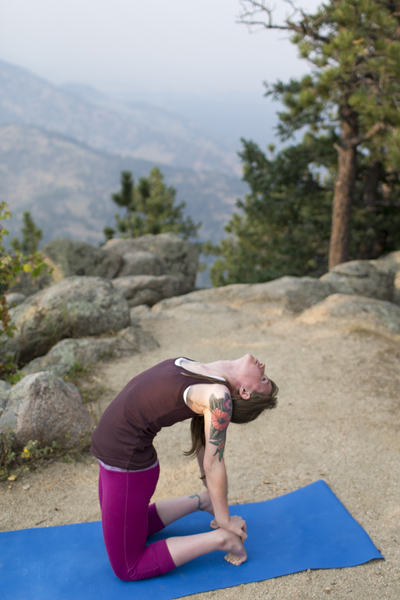
Step-by-Step Instructions for Ustrasana
- Begin by kneeling on the floor with the body upright and the thighs perpendicular to the floor. The legs can be together for the advanced practitioners, or hips distance otherwise. The toes can be tucked under, or the tops of the feet flat to the ground (for the more advanced).
- Place the hands to the lower back, giving a slight concave bend to the spine. Take a few deep breaths here.
- On the exhale, bring the right palm back to the right heal and grab tightly. Then bring the left palm to the left heel. For the full posture it is recommended to place the hands on the palms of the feet; however, this should only be attempted once there is comfort with the hands to the heels.
- Gently bring the head back as you push forward with the spine and pelvic region. The thighs should remain perpendicular to the floor.
- Open through the front of the neck, keeping the cervical spine soft. Avoid rotating the head when holding this posture.
- Keep the breath normal, as the breath will deepen naturally (especially the inhale).
- Hold this pose for 30-60 seconds unless pain arises in the lower back sooner.
- To come out, release the hands one by one and bring them to the lower back area (same as step #2). This should be done with caution to avoid any sudden thrusts or movements to the lower back or spine.
- To counterbalance the pose, come into a gentle forward fold or child’s pose (see pics below), holding for a minimum of 30 seconds, or as long as needed).
**You can also come into this pose by using the side variation which can be a bit easier for beginners. Here are the basic instructions:
- From the kneeling posture described in step #1 above, inhale to bring the left arm up and over towards the right while simultaneously bringing the right hand to meet the top of the right foot. Keep the left arm up and stretched to the right with the gaze soft and to the right. You can see an example in the first picture below.
- Exhale as you release the right hand and come up through center and then repeat on the left side. These movements will begin to warm up the spine. The left side variation can be seen in the second picture below.
- Continue with this vinyasa until your body is ready for the full posture.
- Once the spine is warm and supple, inhale to the right but this time bring the left arm completely overhead until it is able to grab the left heel. The complete pose is shown in the third picture below.
- If the full posture cannot be accomplished, continue with steps #1-3, holding each side bend for several breaths to loosen and warm the spine and lower back. With consistent practice of this variation, the full posture should be achieved overtime.
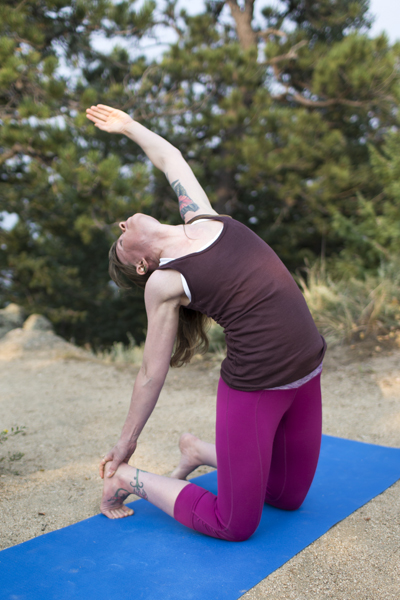
Ustrasana: side variation to the right
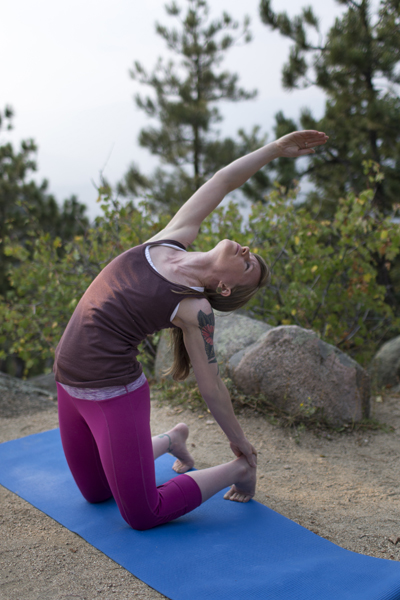
Ustrasana: side variation to the left
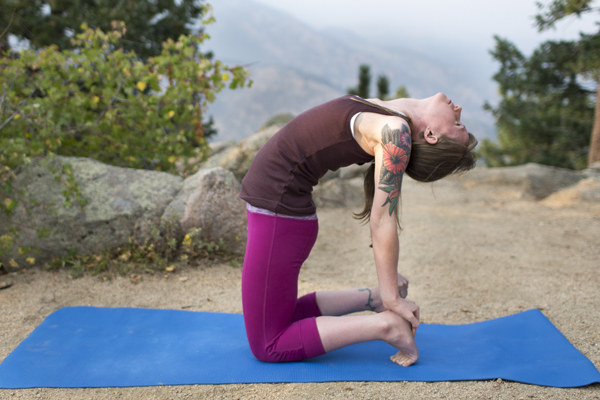
Ustrasana: full pose
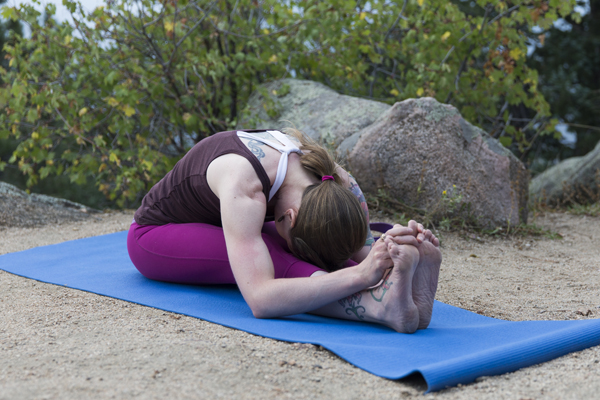
Paschimottanasana: forward fold for counterpose
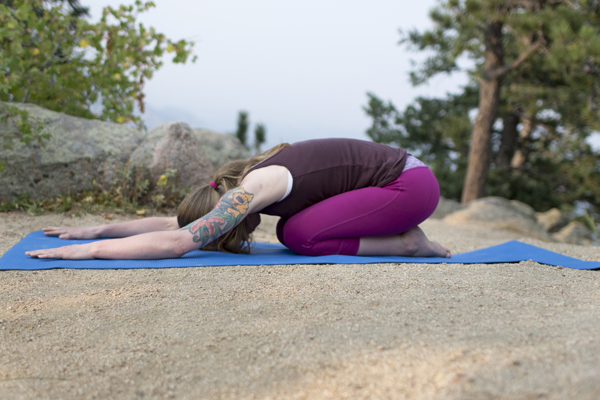
Balasana: child’s pose for counterpose
Click here to see our full apothecary menu.


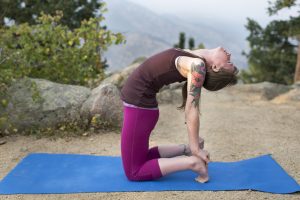


I would like to recieved Your newsletter. Thanks.